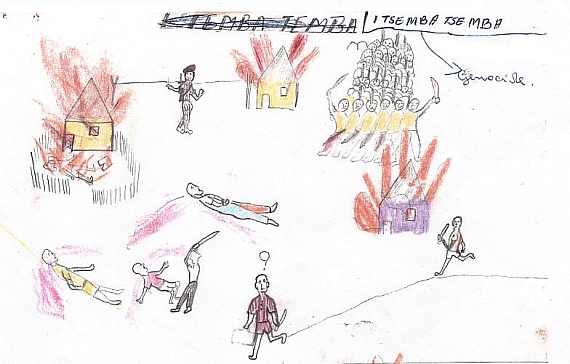- About Ramapo
- Academics
- Admissions & Aid
- Student Life
- Athletics
- Alumni
- Arts & Community
- Quick Links
- Apply
- Visit
- Give
Kwibuka 30, Panel 14
Drawing was one of many therapy techniques used to help child soldiers cope with post-genocide trauma. This drawing titled, “Genocide,” depicts the experiences of a child soldier during the 1994 Genocide Against the Tutsi.
Psychological Impacts on Hutu Child Soldiers
While most of the people who perpetrated genocide were adults, some children were also involved in the violence. Post-genocide Rwanda has thus focused attention on the psychological impacts inflicted upon child soldiers by developing recovery programs specifically geared towards them. One of these programs evolved from UNICEF (the United Nations International Children’s Fund), collaborating with several nongovernmental organizations, and the Rwandan Ministry of Rehabilitation. This program was established following the genocide, and it was known as the Trauma Recovery Program. To identify the specific traumatic symptoms children were experiencing, different exercises were placed into practice. These include storytelling, drawing, writing, dancing, and drama, all centered around Rwandan culture.
Throughout the 1994 Genocide Against the Tutsi, children were manipulated as a means to strengthen the Hutu forces as child soldiers. Children are so vulnerable that they are exploited through propaganda, indoctrination, and misinformation, leading them to become tools of genocide. Even though these children were manipulated into committing the genocide, we cannot forget these young, erstwhile perpetrators were only naive children who were influenced and took orders from those who were above them; therefore, they are not perpetrators, they are victims.
Child soldiers were psychologically manipulated into committing heinous acts through coercion and isolation—disrupting and redirecting their social and emotional development. After recruitment, these children were unable to see their families, making them more susceptible to following the orders of the leaders within the Hutu forces. Child soldiers were also systematically desensitized to the violence they were witnessing because they were placed in the most brutal of the atrocities committed. Child soldiers were restricted in education, which hindered their psychological development, leaving children to believe that grievous violence in childhood is normative. The children are now left with the scars of killing families, friends, and communities; of living with the traumatic guilt of ‘perpetrating’ a genocide.
Quick Links
Rwanda Child Soldiers Global Report 2001
Senga Jeanbaptiste – Child Soldier Testimony
Bibliography
Dyregrov, et al. “Trauma Exposure and Psychological Reactions to Genocide among Rwandan Children.” Journal of Traumatic Stress 13, no. 1 (2000): 3-21.
Grossman, Nienke. “Rehabilitation or Revenge: Prosecuting Child Soldiers for Human Rights Violations.” Georgetown Journal of International Law 38, no. 2 (Winter, 2007): 323-361.
“Lasting Wounds.” Human Rights Watch. March 28, 2023.
Sakai, Caroline E., Suzanne M. Connolly, and Paul Oas. “Treatment of PTSD in Rwandan Child Genocide Survivors using Thought Field Therapy.” International Journal of Emergency Mental Health 12, no. 1 (2010): 41-49.
Wessells, Michael G. Child Soldiers: From Violence to Protection. Cambridge, MA: Harvard University Press, 2009, 22.
Photo Source
“Genocide.” In Witness to Genocide: The Children of Rwanda edited by Richard A. Salem. 2003. Website of Beyond Intractability.
Copyright ©2025 Ramapo College Of New Jersey. Statements And Policies. Contact Webmaster.


Follow Us!